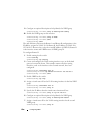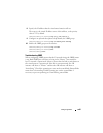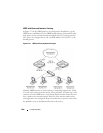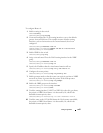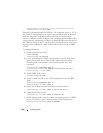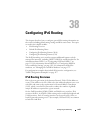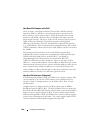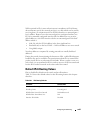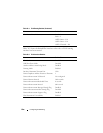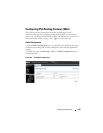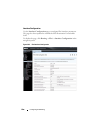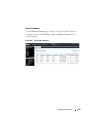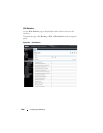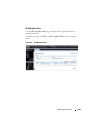
1242 Configuring IPv6 Routing
How Does IPv6 Compare with IPv4?
There are many conceptual similarities between IPv4 and IPv6 network
operation. Addresses still have a network prefix portion (network) and a
device interface specific portion (host). While the length of the network
portion is still variable, most users have standardized on using a network
prefix length of 64 bits. This leaves 64 bits for the interface specific portion,
called an Interface ID in IPv6. Depending upon the underlying link
addressing, the Interface ID can be automatically computed from the link
(e.g., MAC address). Such an automatically computed Interface ID is called
an EUI-64 identifier, which is the interface MAC address with ff:fe inserted in
the middle.
IPv6 packets on the network are of an entirely different format than
traditional IPv4 packets and are also encapsulated in a different EtherType
(86DD rather than 0800 which is used with IPv4). The details for
encapsulating IPv6 in Ethernet frames are described in RFC2462.
Unlike IPv4, IPv6 does not have broadcasts. There are two types of IPv6
addresses — unicast and multicast. Unicast addresses allow direct one-to-one
communication between two hosts, whereas multicast addresses allow one-to-
many communication. Multicast addresses are used as destinations only.
Unicast addresses will have 00 through fe in the most significant octets and
multicast addresses will have ff in the most significant octets.
How Are IPv6 Interfaces Configured?
In Dell Networking N2000, N3000, and N4000 series switches software, IPv6
coexists with IPv4. As with IPv4, IPv6 routing can be enabled on VLAN
interfaces. Each L3 routing interface can be used for IPv4, IPv6, or both
simultaneously.
Neighbor Discovery (ND) protocol is the IPv6 replacement for Address
Resolution Protocol (ARP) in IPv4. The IPv6 Neighbor Discovery protocol is
described in detail in RFC4861. Router advertisement is part of the Neighbor
Discovery process and is required for IPv6. As part of router advertisement,
Dell Networking N2000, N3000, and N4000 series switches software supports
stateless auto configuration of end nodes. The switch supports both EUI-64
interface identifiers and manually configured interface IDs.



